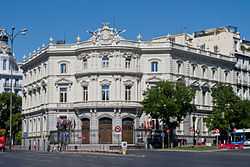Palace of Linares
| Palace of Linares | |
|---|---|
|
Native name Spanish: Palacio de Linares | |
 | |
| Location | Madrid, Spain |
| Coordinates | 40°25′11″N 3°41′32″W / 40.419821°N 3.692245°WCoordinates: 40°25′11″N 3°41′32″W / 40.419821°N 3.692245°W |
| Official name: Palacio de Linares | |
| Type | Non-movable |
| Criteria | Monument |
| Designated | 1976[1] |
| Reference no. | RI-51-0004230 |
 Location of Palace of Linares in Spain | |
The Palace of Linares (Spanish: Palacio de Linares) is a palace located in Madrid, Spain. It was declared Bien de Interés Cultural in 1976.[1]
According to the rumour mill in Madrid, Linares Palace lock up the ghosts of the first Marquis de Linares, like that of a child, their daughter. According to this legend, José de Murga y Reolid would have confessed to his father, the rich merchant Mateo Murga y Michelena, he fell in love with a poor girl, Raimunda Osorio, presumably daughter of a cigarette seller. By knowing your father the name of the young, horrified, he would have sent his son to London in order to make him forget that young lady. The reason for his fear would be given by the fact that humble girl would have been the fruit of extramarital love by Mateo himself and therefore both lovers were half brothers.
The legend places Mateo died and the young newlyweds. In such a situation José would have found a letter from his father addressed to him in which he explained the reasons for his opposition to such a relationship. Jose and Raimunda, aware of the incestuous sin allegedly committed, would have been addressed to Pope Pius IX, who eventually would have granted a papal bull called Casti convivere, that is, to live together but in chastity. However, the love they have made them overlook their relationship half brothers and have engendered a daughter, who allegedly murdered as a child to avoid a scandal. Such daughter, Raimundita would have been walled or drowned and buried in the palace itself and, according to this legend, today, her spirit paces the great halls of the old palace singing children's songs and calling their parents.
References
- ↑ 1.0 1.1 Database of protected buildings (movable and non-movable) of the Ministry of Culture of Spain (Spanish).